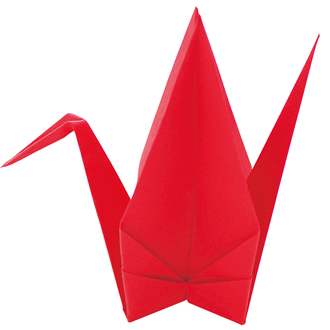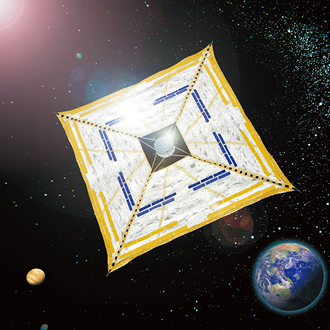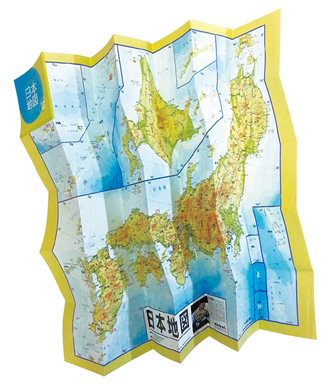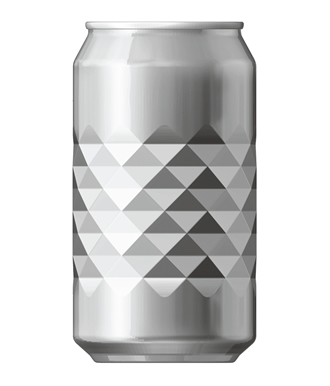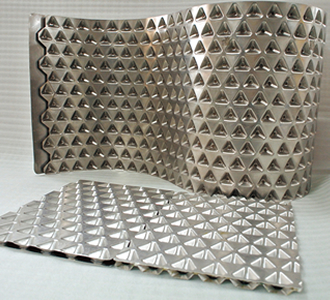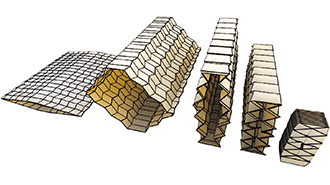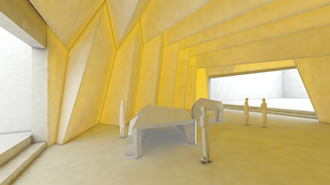niponica is a web magazine that introduces modern Japan to people all over the world.
2016 No.18
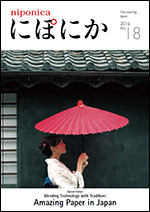
To read the e-book you need to have JavaScript enabled in your browser and a free Flash Player plug-in from Adobe Systems Inc. installed.
Amazing Paper in Japan

Innovation from Origami
Collaboration: TAKEO Co., Ltd.

Miura-ori folds made with colorful Fine Paper. (Photo: Hirata Masakazu, Hakuhodo Product’s Inc. / Shown at the “Breathing of ORIGAMI” Mihoncho Honten Exhibition, TAKEO Co., Ltd.)
Make a bird, an animal, a plant or a geometrical shape by folding a single sheet of paper. Many Japanese became fond of origami in their youth.
Origami is now attracting attention in the fields of science and technology as well. Origami engineering uses the techniques and special characteristics of origami to manufacture things. Using computer technology, engineers have developed design methods called computational origami, treating origami as a mathematical tool to expand the potential of a craft that was until recently a pastime for kids. The originality and methods of origami engineering are attracting worldwide attention, because they are being applied in many fields, from the space industry and automotive sector to medical treatment and fashion. Especially well known are miura-ori folds, a folding method developed for the design of structures for space exploration. Common examples of miura-ori folds are seen on maps and beverage cans.
“Origami’s most famous example is the crane. But it doesn’t look much like a real crane because it is simplified and abstract; in other words, we fold the piece of paper to make a simple shape that somewhat resembles a crane, or at least represents it. I’d say this is one aspect of the sensitivity of the Japanese and their interesting perspective on three-dimensional structures,” says Hagiwara Ichiro, a professor at Meiji University in Tokyo. His research looks for ways to apply and promote origami engineering for different purposes. Truss Core panels, which he developed, were inspired by 3D origami concepts. Two panels, which are generally made of metal or plastic, are embossed with rows of triangular pyramids, and then placed face to face to make a structure that is light yet crush resistant. Truss Core panels are used in solar arrays to generate electricity.
Professor Hagiwara is also working on the development of an origami-type 3D printer. His system converts the 3D data of a three-dimensional object into a two-dimensional figure with many plane faces. The figure is printed with an ordinary printer. The result is faster and cheaper than what could be obtained with a conventional 3D printer, which builds up layers of material. And his method can be used to make large three-dimensional objects. Expected uses include the manufacture of product samples and pre-production prototypes. This method could quite likely be used in urban planning, by reproducing buildings and other structures from aerial photographs.
Origami is unusual in a number of ways, especially the folding methods, how the object is formed, and its ability to be folded either in or out. All these features make origami concepts useful in building construction. Tachi Tomohiro, an assistant professor at the University of Tokyo, is researching ways to use origami techniques in architecture. The key to success, he says, is to use flat “rigid origami” panels and assemble them into a strong, flexible structure. The structural components are easy to fold in and out, offering applications like retractable roofs and furniture such as tables. And because the structures are light and easy to transport, they are suitable for short-term display facilities, or temporary housing for people displaced after a disaster.
“A fold-out pavilion used at an exhibition can be folded up and taken to a disaster-stricken area for shelter. The materials are reused, not thrown away. The building would have a built-in ‘memory’ for future use.”
In the old days origami played a role in etiquette, when giving a present. Today there is still the sen-ba-zuru custom, folding 1,000 pieces of paper to make a thousand cranes, in a get-well wish for an invalid. Each fold, one after the other, expresses the desire to be of use. The desire to make something of use is alive in origami engineering.
Assistant professor Tachi explains origami’s charm:
“Origami has Japanese qualities, but it is also universal, global. Origami research extends across multiple disciplines to include engineering, mathematics, the natural sciences, medicine, education and design. So I feel it has lots of potential.”
This traditional Japanese pastime for hands is being transformed by researchers in different parts of the world into cutting-edge technologies. Origami is ready to drive innovation in 21stcentury manufacturing.
Map creased using miura-ori folds. When the map is closed, hold just the top left and bottom right corners, and then pull. The map will open up all the way in a flash. (Photo: miura-ori-lab)
Truss Core panels are strong and can be made into many things, including a sound insulator or a heat insulator to withstand fire. Other expected uses include structural components for railway cars, aircraft and buildings. (Photo: Shiroyama Industry)
Rigid origami panels moved into different configurations. From left: Beginning flat, the structure becomes a threedimensional body with the potential for vertical and horizontal expansion. It can even be folded small.



